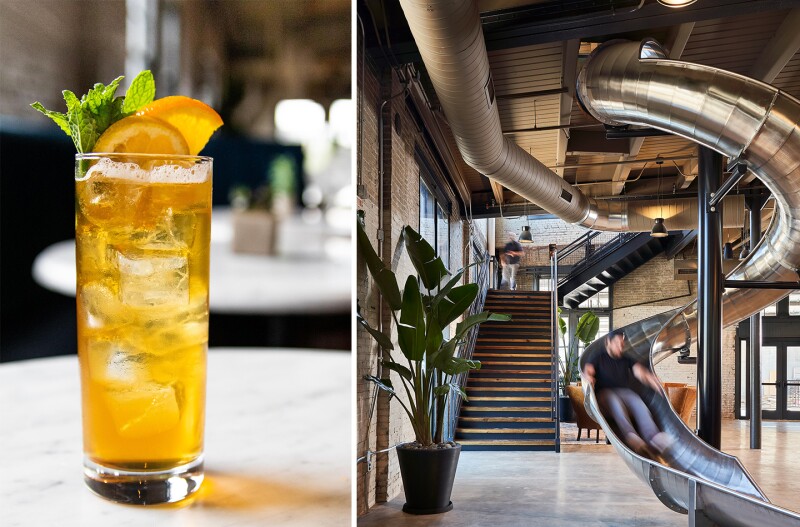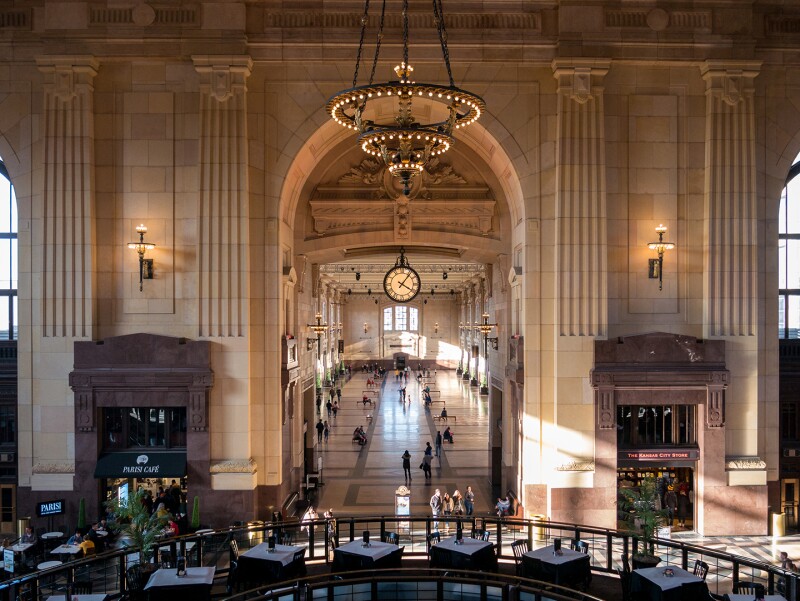Think of Kansas City and barbecue and blues may come to mind, but there’s so much more in this cow town/arts destination than smoked meat and music. With world-class museums and galleries and impressive theater, dance, and opera, the cultural offerings here are on par with much larger cities.
The city’s culinary scene, for example, has recently been spiced up with several new international flavors, including those at Palestinian American deli Baba’s Pantry and Vietnamese coffeehouse Café Cà Phê. A shiny new terminal at Kansas City International Airport, meanwhile, offers a taste of the destination as soon as you arrive, with some 80 percent of the brands local to the region, 17 of them women- or minority-owned.
For those who prefer sports to the symphony, there are the Kansas City Royals and the 2024 NFL Champion–winning (and Swift-approved) Chiefs, who have brought the city back-to-back Super Bowl titles since 2023. Kansas City is also home to the brand-new CPKC Stadium, the world’s first stadium built for a professional women’s sports team. Win or lose, both teams bring much excitement and hometown pride to the city. Whether you’ve come to shop the famous Country Club Plaza, see powerful murals, or experience the city’s vibrant distillery scene, you can expect to be surprised by the City of Fountains.
Read on for eight of the best things to do in Kansas City. (And if you’re looking for the best hotels in Kansas City, we’ve got that covered too.)

Circular Mill Creek Fountain is one of Kansas City’s many fountains on public land.
Photo by Bonnie Davidson/Shutterstock
1. Discover Kansas City’s famous fountains
The City of Fountains Foundation wasn’t founded until 1973, but Kansas City’s love affair with fountains started much earlier. A vision by city leaders in the late 1800s to create “more boulevards than Paris, more fountains than Rome” led to the first few, which were used primarily as watering holes for residents and animals. As time went on, however, fountains were installed more as memorials or for beautification of the city and, today, KC is home to more than 200, 48 of which are on public land and available for tourists to view.
The city’s oldest working fountain, the Women’s Leadership Fountain in the Paseo West neighborhood, dates back to 1899. More celebrated examples appear in the Country Club Plaza shopping center and green spaces like Kessler Park. For a fun day of fountain hopping, start at the city’s most recognizable—and most photographed—one, the Mill Creek Fountain. Built in Paris in 1910, it was brought to Kansas City in 1951 and installed in its namesake park.
Afterward, head to Union Station to see the towering spouts of the Henry Wollmach Bloch Fountain, which features 232 water jets, then carry on to the Crown Center Square Fountain, where children dance in sprays choreographed to recorded performances by the Kansas City Symphony. End your exploration at the Nelson-Atkins Museum of Art (free admission) to view the Fountain Basin; the oldest fountain with a marble bowl, it dates back to 220 C.E. and was purchased from Italy.

Learn all about the Great War and how it changed America forever at the National World War I Museum.
Courtesy of Visit KC
2. Visit the American Jazz Museum and other world-class institutions
For a midsize city, Kansas City has several exceptional museums. Visit the Nelson-Atkins Museum of Art to see the giant shuttlecock sculptures on the front lawn as well as robust Asian art, ceramic, photography, and centuries-old furniture collections, or spend the day at the National World War I Museum and Memorial ($18 for adult nonmembers), the only U.S. museum exclusively dedicated to remembering, interpreting, and understanding that war and its enduring impact. Other popular institutions include the American Jazz Museum ($10 for adults) in the 18th & Vine Historic Jazz District (where you can visit Missouri’s first Black-owned brewery, Vine Street Brewing Co.). And don’t miss the essential Negro Leagues Baseball Museum ($10 for adults), which works to preserve and celebrate the rich history of African American baseball and its impact on the social advancement of the United States.
If you’re after an adrenaline-filled dose of family adventure, amusement park Worlds of Fun lives up to its name. Fan favorite coaster, the Zambezi Zinger, reopened last year, and it’s a ride you cannot miss, hitting speeds of 45 mph during two minutes of thrills. The Kansas City Zoo is also perfect for family fun. It recently opened the Sobela Ocean Aquarium, which contains more than 8,000 ocean animals.
Watch: Negin Farsad Takes a Trip to Kansas City
How to visit
Tickets or reservations for all of the four museums mentioned can be secured in advance. With a few exceptions, all four are open from 10 a.m. to 5 p.m. daily. Nelson-Atkins is closed Tuesday and Wednesday but open until 9 p.m. on Fridays; the World War I Museum and Negro Leagues Baseball Museum are closed on Mondays. The American Jazz Museum closes early at 3 p.m. on Mondays.

Country Club Plaza is known for its Spanish-inspired architecture and excellent shopping.
Courtesy of Visit KC; Photo by barteverett/Shutterstock
3. Shop at Country Club Plaza
Kansas City’s premier shopping center, Country Club Plaza is the place to be, whether during the holidays for the Plaza Lighting Ceremony, over the summer for a gondola ride along Brush Creek, or come fall when it hosts the Plaza Art Fair (free admission). The 15-block destination, filled with Spanish-inspired architecture, is also an appealing place to shop any time of year. It celebrated its centennial in 2023. You’ll find high-end stores like Coach, Tiffany & Co., and Charlie Hustle, as well as singular boutiques and spots like Made in Kansas City, where you can pick up locally made items like hats, candles, and drinkware.
How to visit
Most stores are open from 10 a.m. to 7 p.m. (12–6 p.m. on Sundays) although many restaurants and bars are open later (hours vary). Free parking is available on site.

For some of KC’s most exciting art, take to the streets to check out all the murals.
Photo by Lisa Corson
4. Tour Kansas City’s many murals
Kansas City may be home to some of the Midwest’s top museums and galleries, but much of the city’s most exciting art is found on the streets. Start your tour in the 18th and Vine District to view murals that celebrate Kansas City’s jazz history, then head to the corner of West 43rd Street and Westport Road to see a painting of Ruth Bader Ginsburg. Finish at East 17th and Main streets, where, on the side of Tom’s Town Distilling, you’ll find the Chiefs Kingdom Mural honoring the city’s championship football team.

One of Kansas City’s originally distilleries, J. Rieger and Co. offers tours, tastings, and a stylish cocktail bar.
Courtesy of J. Rieger & Co.
5. Visit a distillery and get a taste of KC cocktail culture
Thanks in part to corrupt political boss Tom Pendergast, Kansas City maintained a thriving drinking scene during Prohibition.
This devotion to good drinks remains today, evidenced by several top-notch distilleries around town. Founded in 1887, J. Rieger & Co. produced more than 100 alcoholic products before being forced to close in 1919 with the advent of Prohibition. Ninety-five years later, it reopened in its original location in the Electric Park district of the East Bottoms and now distills whiskey, dry gin, wheat vodka, and other spirited products. Open to visitors Wednesdays through Sundays, it also offers facility tours, spirit tastings ($20 for adults), and the Monogram Lounge, where you can sip cocktails overlooking the distillery production floor.
Other KC distilleries worth visiting include Mean Mule Distilling Co., which makes American agave spirits; Tom’s Town Distilling Company, named for Pendergast and home to award-winning gin, vodka, and bourbon; and Lifted Spirits Distillery, which produces boldly flavored spirits like green absinthe.

River Market is home to one of the largest farmers’ market in the region.
Photo by Lisa Corson
6. Explore the historic River Market area
While Kansas City’s River Market neighborhood is primarily known for its weekend farmers’ market, it’s more than a place to buy fruits and vegetables. After shopping for produce, plants, and locally made trinkets at City Market, browse the surrounding stores (don’t miss Carollo’s Italian Grocery and Deli, with its homemade sausage, fresh cheese, and olive oil stored in barrels), then take a stroll to Berkley Park and enjoy the views over the Missouri River.
For a window into the past, swing by the old-timey Planters Seed & Spice Co. before hitting the Arabia Steamboat Museum ($16.50 for adults), where you’ll find an impressive collection of pre–Civil War artifacts. Later, refuel with a cappuccino at City Market Coffee or a sandwich at Pigwich, located within the Local Pig butchery.

Full of flowers, fountains, and sculptures, the Kauffman Memorial Garden is a lovely place to spend an hour.
Courtesy of Ewing Marion Kauffman Foundation
7. Discover the Ewing and Muriel Kauffman Memorial Garden
A gift to Kansas City from pharmaceutical entrepreneur Ewing Kauffman and his wife Muriel, this two-acre garden is a gorgeous place to visit. The couple designed the garden to mimic parks throughout Europe, pairing colorful perennial beds and many unique trees with stone walls, brick walkways, fountains, and bronze sculptures by Tom Corbin.
How to visit
Parking and admission are free, though visitors can also book prearranged tours to more thoroughly explore the grounds.

Union Station is more than a transportation hub, with restaurants, a theater, and a science center.
Photo by APN Photography/Shutterstock
8. Shop, eat, and be entertained at historic Union Station
Built in 1914, this architectural gem served as a working railway station until the 1980s, when it closed after years of neglect. In 1999, however, it reopened after a historic renovation that removed more than 10 million pounds of debris and restored the building to its original glory—all 850,000 square feet of it. Today, Union Station still serves Amtrak trains, but it also houses classic restaurants like Pierpont’s and Harvey’s, live entertainment at City Stage Theatre, a planetarium, a science center, and more. While visiting, be sure to also check out the massive chandeliers, 95-foot-high ceiling, and six-foot-wide clock in the Grand Hall.
This article was originally published in May 2021. It’s been updated several times, most recently in June 2024. Tim Chester contributed reporting.











